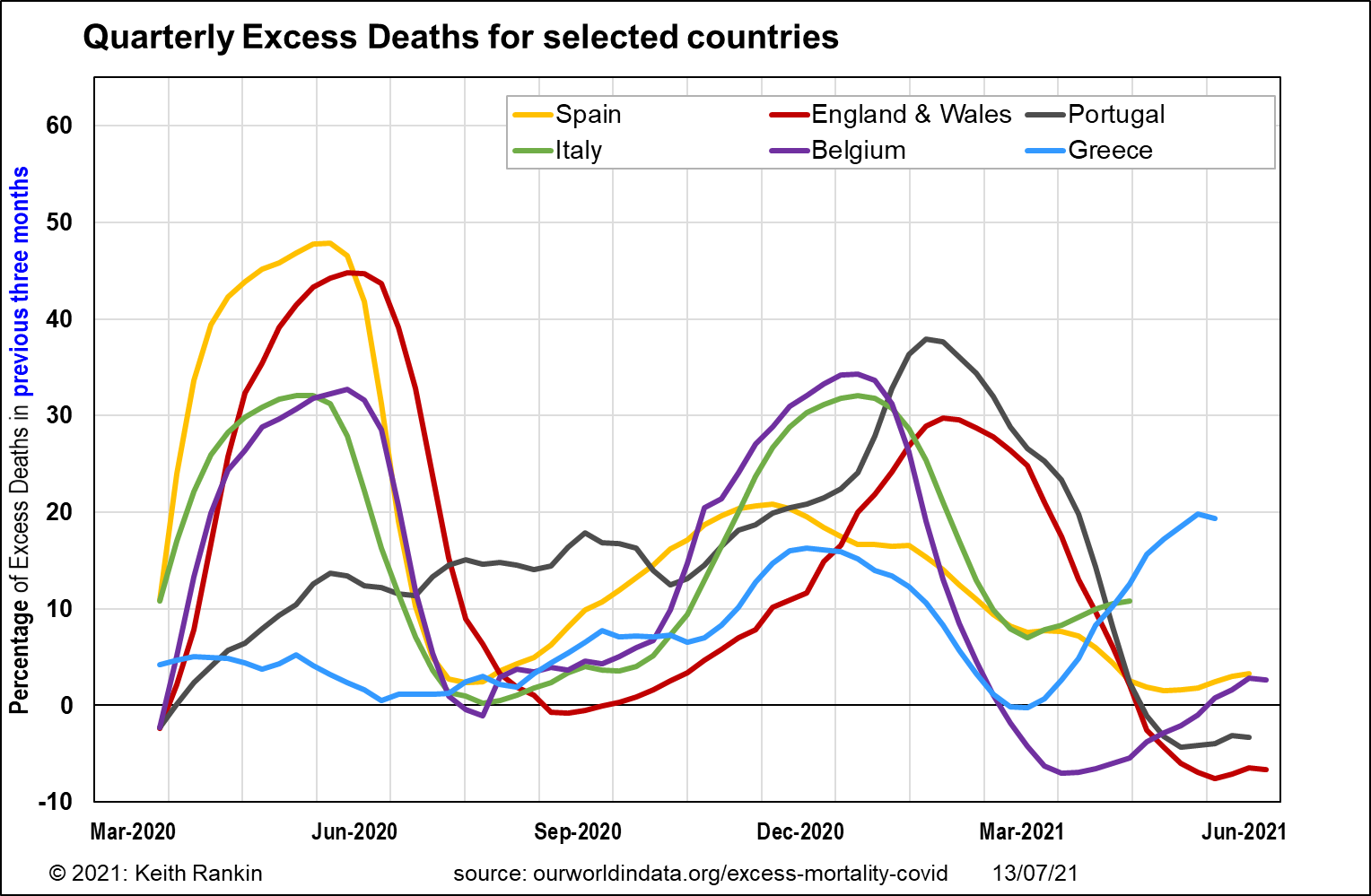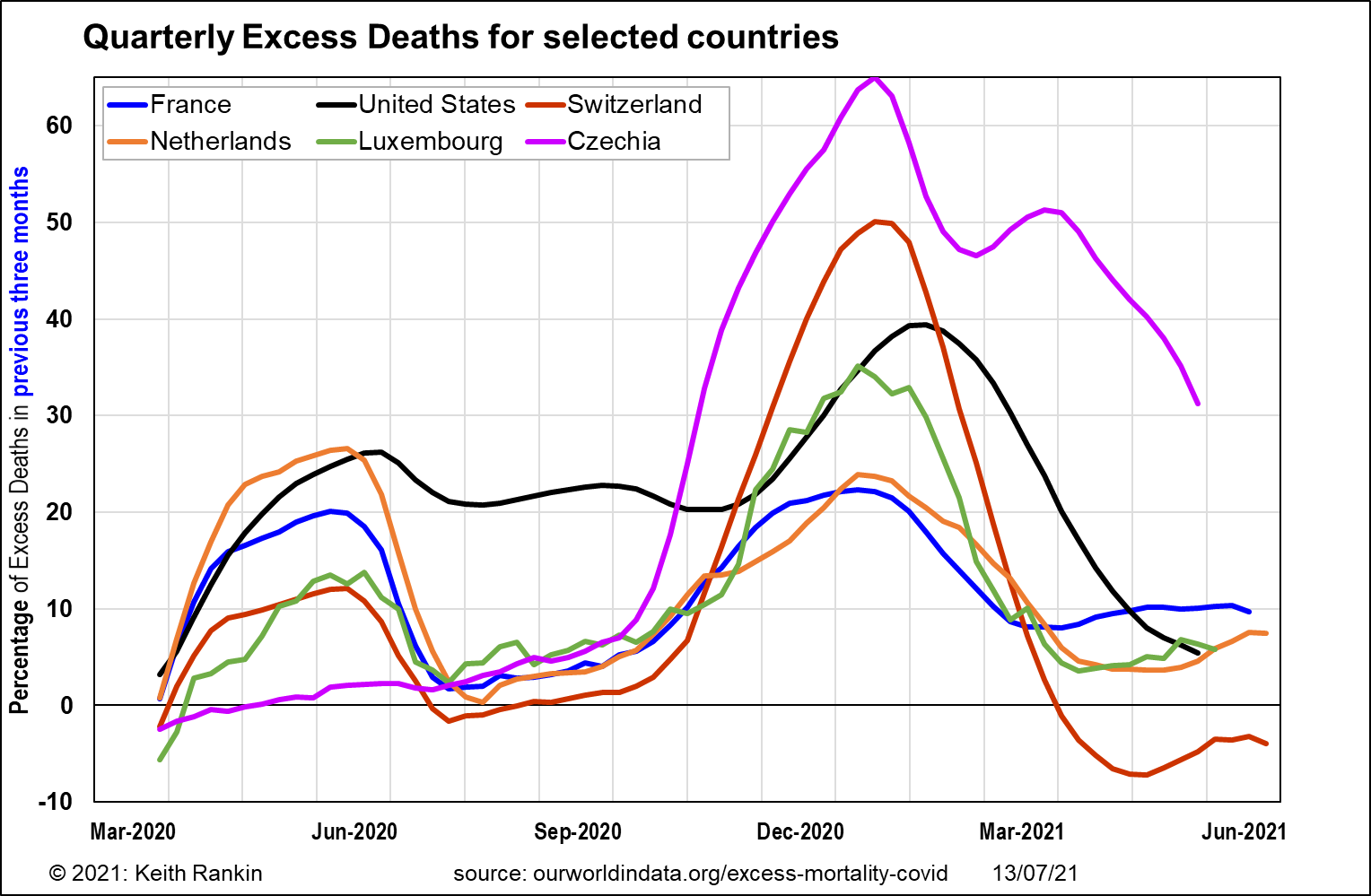Analysis by Keith Rankin.

We now have excess death data for most of western Europe, until the end of June 2021. The peaks are all due to Covid19.
We can see clearly that the pandemic in Europe began simultaneously in Italy and Spain, and almost certainly in January 2020. While we are yet to even try to tell the story about how Covid19 got to these two countries, it is most likely to have been due to multiple incursions by air from China, possibly in some cases via Chinese territories such as Macau and Hong Kong.
In the case of Italy, it seems like to have been due to economic ties; in particular the area around Milan in Italy is that country’s technological and entrepreneurial hub. Travel to the World Economic Forum in the Swiss Alps city of Davos, may have been part of the story. Certainly, Covid19 soon got from the Milan area to the ski resorts in the Alps. And from these resorts – in the February school holidays – Covid19 got into northwest Europe.
In the case of Spain, it seems likely – in mid-late-January – to have been a preferred European destination for wealthy Chinese tourists and covid-evacuees. Indeed I understand that a Wuhan football team evacuated to the south of Spain. Portugal was not nearly as affected as Spain, initially. Covid19 travelled mainly by air.
I am guessing that England got the covid-bug both from the Alps, and from English people who live in the south of Spain; such British people travel frequently by air between Spain and England. In Belgium covid seems to have been brought in mainly by holidaying Eurocrats, and then unwittingly transmitted into the rest homes for the elderly.
The subsequent dynamic, for these countries, was mainly summer travel within Europe. We see that, from the three months ended October 2020, Portugal’s excess deaths closely match England’s. (In the period before that, Portugal’s inability to shake-off Covid19 was most likely linked to its relationship with Brazil.)
We also note that the early second wave in Spain is likely to have originated in England, which is a large country whose people enjoy flying to places like Spain and Greece; England still had more active covid than did other northwestern European countries when intra-European tourism restarted. Greece seems to have got Covid19 this way, although it’s 2021 experience seems to be more linked to its East Europe neighbours than to West Europe.
The later timing of West Europe’s second wave in Italy and Belgium looks to be linked to returning tourists. The second chart, below, shows France, Netherlands and Luxembourg peaking at the same time as Italy and Belgium.

The other important dynamic in West Europe’s second wave is the youth tourist wave from the United States. Young Americans have certain particularly favoured destinations: Barcelona, Paris, Amsterdam, Prague (in Czechia), and Switzerland. We see early beginnings of the West Europe’s second wave in France, Netherlands and especially Czechia. Czechia’s wave was the important link to the rest of East Europe. Czechia aside, it is Switzerland that easily suffered the most in West Europe’s second wave of Covid19. (Note that smaller tourist-oriented countries will generally show greater amplitudes of variation; the tourist impact in Switzerland is greater per capita than is the tourist impact in France.)
West Europe’s Third Wave
The third wave has begun, with England leading the way. The countries most affected by West Europe’s third wave so far are ranked (in the world, per capita), for the seven days ending 11 July :
- United Kingdom (9th for cases, 79th for deaths)
- Ireland (55th, 111st)
- Channel Islands (6th, 159th=)
- Gibraltar (19th, 159th=)
- Portugal (21st, 68th)
- Spain (15th, 95th)
- Andorra (18th, 159th=)
- Netherlands (14th, 133rd)
- Denmark (60th, 139th)
- Luxembourg (28th, 103rd)
- Greece (39th, 65th)
- Cyprus (3rd, 120th) [ may be connected to Russia]
Time will tell whether the death rates will rise dramatically in response to recent high case numbers.
The hope will be that the case-fatality ratios will be much less this time, thanks to the vaccination of older and more vulnerable people, and thanks to it being summer. Indeed, this phase should be the beginning of the end of the pandemic, because the seasonal intermingling of people – young people in particular – will give widespread immunity to the young unvaccinated population; including, crucially, the many vaccine resistant people in Europe.
The proof will be the coming northern autumn and winter. If this works out, Covid19 will become a variant of the common cold, as the ‘Russian flu’ of 1889-90 (most likely a coronavirus) became. I am sure that this summer intermingling of young people is the critical final step to the resolution of this pandemic.
The most probable reason why this optimal scenario may not happen will be if winter booster vaccinations are not provided to the already vaccinated population.
—————
Note: New Zealand and MIQ
New Zealand will need to have higher regular Covid19 vaccinations, given the likely substantially lower level of ongoing immunity in the younger population. Further, all is generally far from well in this southern Garden of Eden.
The big scandal at present is the paucity of places in MIQ (managed isolation and quarantine). On the surface the government has taken a rather cruel approach to people who need to travel to New Zealand, and to people in New Zealand who are not deemed to be permanent residents.
While the word ‘cruel’ is probably apt, in an important sense the government may have been ‘hoisted by its own petard’. The present single-party government of New Zealand practices the ideology of economic nationalism – a closely related dogma to that of mercantilism – which means that it is philosophically opposed to immigration. The problem is that the government’s MIQ program is hamstrung by a labour shortage; a shortage that can only be resolved, in the short and medium term, by immigration. We need to expand MIQ before we can expand MIQ; Catch22.








